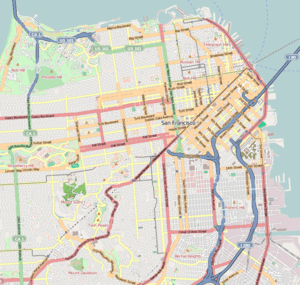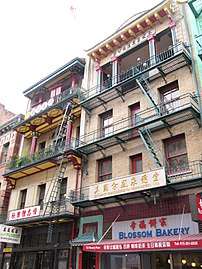Tin How Temple
| Tin How Temple | |
|---|---|
| 天后古廟 | |
.jpg) Entrance to Tin How Temple at 125 Waverly Place in San Francisco's Chinatown | |
 Shown within San Francisco  Tin How Temple (San Francisco Bay Area) | |
| Basic information | |
| Location | 125 Waverly Pl |
| Geographic coordinates | Coordinates: 37°47′40″N 122°24′26″W / 37.79457°N 122.40710°W |
| Affiliation | Taoism |
| Municipality | San Francisco |
| District | Chinatown |
| State | California |
| Country | USA |
The Tin How Temple (also spelled Tianhou Temple, simplified Chinese: 天后古庙; traditional Chinese: 天后古廟; pinyin: Tiānhòu gǔ miào) is the oldest extant Taoist temple in San Francisco's Chinatown, and one of the oldest still-operating Chinese temples in the United States.[1] It is dedicated to the Chinese sea goddess Mazu, who is known as Tin How (天后, Empress of Heavens) in Cantonese.[2]
History
The temple was founded in 1852, reportedly at its current location at 125 Waverly Place, by Day Ju, one of the first Chinese persons to arrive in San Francisco.[3] The building was later destroyed in the 1906 earthquake and fire, with the image of the goddess, the temple bell, and part of the altar surviving.[1] By then, ownership of the building site had transitioned to the Sue Hing Benevolent Association,[4] which reopened it in 1910 on the top floor of a four-story building it built on the site.[1] The temple closed in 1955 and reopened on May 4, 1975,[2] after the Immigration and Nationality Act of 1965 had caused a rejuvenation of San Francisco's Chinatown.[1]
In May 2010, the one-hundredth anniversary of the temple was celebrated by a religious procession through the streets in the neighborhood, including dances and fireworks. The temple is a significant landmark in Chinatown; the Chinese name for Waverly Place is 天后庙街; 天后廟街; Tiānhòu miào jiē; "Tin How Temple Street".[2]
Visiting
The temple is open daily between 10 A.M. and 4 P.M., excepting holidays.[5] Admission is free with permission from the attendant, and donations are accepted. Photography is not allowed inside the temple.[3]
See also
Although both are dedicated to Mazu, the Tin How Temple is not to be confused with the "Ma-Tsu Temple of U.S.A." two blocks north of it, which was founded in 1986 with ties to the Chaotian Temple in Taiwan.
Gallery
 Tin How Temple (left building, top floor)
Tin How Temple (left building, top floor).jpg) View of Transamerica Pyramid, Embarcadero Center, and Hilton San Francisco Financial District from temple balcony
View of Transamerica Pyramid, Embarcadero Center, and Hilton San Francisco Financial District from temple balcony.jpg) Jingxiang temple altar
Jingxiang temple altar.jpg) Devotee lanterns; donor names are written on red paper and attached to the lanterns
Devotee lanterns; donor names are written on red paper and attached to the lanterns
References
- 1 2 3 4 Lorentzen, Lois Ann; Gonzalez, Joaquin Jay; Chun, Kevin M.; Do, Hien Duc (2010-07-01). Religion at the Corner of Bliss and Nirvana: Politics, Identity, and Faith in New Migrant Communities. Duke University Press. p. 169. ISBN 0822391163.
- 1 2 3 "Tin How Temple". chinatownology.com. Retrieved 15 March 2018.
- 1 2 "Tin How Temple". Fodor's Travel. Retrieved 15 March 2018.
- ↑ Kam, Katherine (9 December 2001). "Where Chinatown Reveals Itself". The New York Times. Retrieved 15 March 2018.
- ↑ "Tin How Temple". lonely planet. Retrieved 15 March 2018.
External links
| Wikimedia Commons has media related to Tin How Temple. |
- Tin How Temple at chinatownology.com
- Dr. Weirde. "Chinese Temples in San Francisco". FoundSF. Retrieved 15 March 2018.
- Wach, Bonnie (6 February 2004). "Tour For San Francisco Virgins". San Francisco Chronicle. Retrieved 15 March 2018.